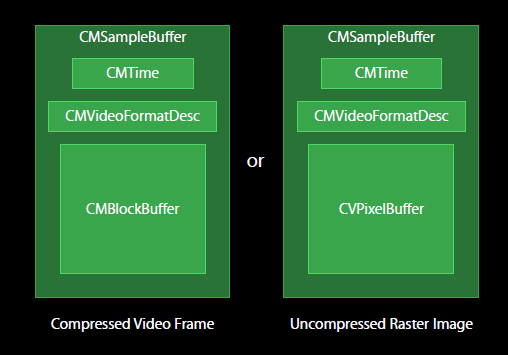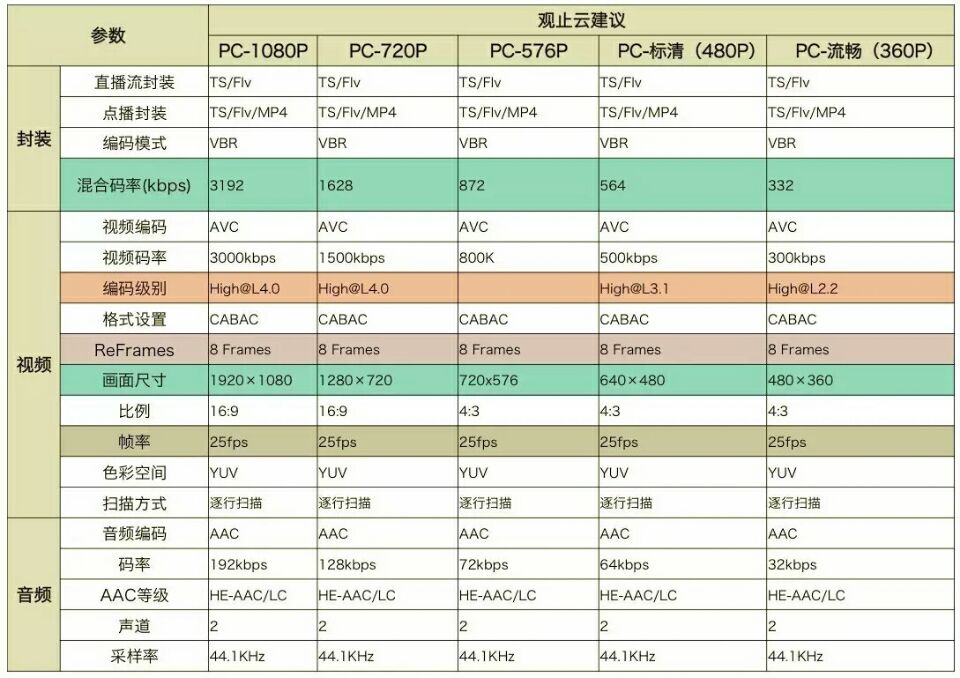硬编码相对于软编码来说,使用非CPU进行编码,如显卡GPU、专用的DSP、FPGA、ASIC芯片等,性能高,对CPU没有压力,但是对其他硬件要求较高(如GPU等)。
在iOS8之后,苹果开放了接口,并且封装了VideoToolBox&AudioToolbox两个框架,分别用于对视频&音频进行硬编码,音频编码放在后面做总结,这次主要总结VideoToolBox。
Demo的Github地址:https://github.com/wzpziyi1/HardCoding-For-iOS
1、相关基础数据结构:
CVPixelBuffer:编码前和解码后的图像数据结构。
CMTime、CMClock和CMTimebase:时间戳相关。时间以64-bit/32-bit的形式出现。
CMBlockBuffer:编码后,结果图像的数据结构。
CMVideoFormatDescription:图像存储方式,编解码器等格式描述。
CMSampleBuffer:存放编解码前后的视频图像的容器数据结构。

// 编码完成回调 void finishCompressH264Callback(void *outputCallbackRefCon, void *sourceFrameRefCon, OSStatus status, VTEncodeInfoFlags infoFlags, CMSampleBufferRef sampleBuffer) { if (status != noErr) return; //根据传入的参数获取对象 ZYVideoEncoder *encoder = (__bridge ZYVideoEncoder *)(outputCallbackRefCon); //判断是否是关键帧 bool isKeyFrame = !CFDictionaryContainsKey( (CFArrayGetValueAtIndex(CMSampleBufferGetSampleAttachmentsArray(sampleBuffer, true), 0)), kCMSampleAttachmentKey_NotSync); //如果是关键帧,获取sps & pps数据 if (isKeyFrame) { CMFormatDescriptionRef format = CMSampleBufferGetFormatDescription(sampleBuffer); //获取sps信息 size_t sparameterSetSize, sparameterSetCount; const uint8_t *sparameterSet; CMVideoFormatDescriptionGetH264ParameterSetAtIndex(format, 0, &sparameterSet, &sparameterSetSize, &sparameterSetCount, 0); // 获取PPS信息 size_t pparameterSetSize, pparameterSetCount; const uint8_t *pparameterSet; CMVideoFormatDescriptionGetH264ParameterSetAtIndex(format, 1, &pparameterSet, &pparameterSetSize, &pparameterSetCount, 0 ); // 装sps/pps转成NSData,以方便写入文件 NSData *sps = [NSData dataWithBytes:sparameterSet length:sparameterSetSize]; NSData *pps = [NSData dataWithBytes:pparameterSet length:pparameterSetSize]; // 写入文件 [encoder gotSpsPps:sps pps:pps]; } //获取数据块 CMBlockBufferRef dataBuffer = CMSampleBufferGetDataBuffer(sampleBuffer); size_t length, totalLength; char *dataPointer; OSStatus statusCodeRet = CMBlockBufferGetDataPointer(dataBuffer, 0, &length, &totalLength, &dataPointer); if (statusCodeRet == noErr) { size_t bufferOffset = 0; // 返回的nalu数据前四个字节不是0001的startcode,而是大端模式的帧长度length static const int AVCCHeaderLength = 4; //循环获取nalu数据 while (bufferOffset < totalLength - AVCCHeaderLength) { uint32_t NALUnitLength = 0; //读取NAL单元长度 memcpy(&NALUnitLength, dataPointer + bufferOffset, AVCCHeaderLength); // 从大端转系统端 NALUnitLength = CFSwapInt32BigToHost(NALUnitLength); NSData* data = [[NSData alloc] initWithBytes:(dataPointer + bufferOffset + AVCCHeaderLength) length:NALUnitLength]; [encoder gotEncodedData:data isKeyFrame:isKeyFrame]; // 移动到写一个块,转成NALU单元 bufferOffset += AVCCHeaderLength + NALUnitLength; } } }
所需要的信息都可以从CMSampleBufferRef中得到。
2、NAL(网络提取层)代码讲解
直播一中提到了NALU概念上的封装,下面是代码部分:
代码B:
- (void)gotSpsPps:(NSData*)sps pps:(NSData*)pps
{
// 拼接NALU的header
const char bytes[] = "x00x00x00x01";
size_t length = (sizeof bytes) - 1;
NSData *ByteHeader = [NSData dataWithBytes:bytes length:length];
// 将NALU的头&NALU的体写入文件
[self.fileHandle writeData:ByteHeader];
[self.fileHandle writeData:sps];
[self.fileHandle writeData:ByteHeader];
[self.fileHandle writeData:pps];
}
- (void)gotEncodedData:(NSData*)data isKeyFrame:(BOOL)isKeyFrame
{
NSLog(@"gotEncodedData %d", (int)[data length]);
if (self.fileHandle != NULL)
{
const char bytes[] = "x00x00x00x01";
size_t length = (sizeof bytes) - 1; //string literals have implicit trailing '�'
NSData *ByteHeader = [NSData dataWithBytes:bytes length:length];
[self.fileHandle writeData:ByteHeader];
[self.fileHandle writeData:data];
}
}
结合这张图片:

一个GOP序列,最前面是sps和pps,它们单独被封装成两个NALU单元,一个NALU单元包含header和具体数据,NALU单元header序列固定为00 00 00 01。那么得到一帧画面时,需要判断该帧是不是I帧,如果是,那么取出sps和pps,再是相关帧的提取写入。(具体参考代码A)。
3、VTCompressionSession进行硬编码
a、给出width、height
b、使用VTCompressionSessionCreate创建compressionSession,并设置使用H264进行编码,相关type是kCMVideoCodecType_H264
c、b中还需要设置回调函数finishCompressH264Callback,需要在回调函数里面取出编码后的GOP、sps、pps等数据。
d、设置属性为实时编码,直播必然是实时输出。
e、设置期望帧数,每秒多少帧,一般都是30帧以上,以免画面卡顿
f、设置码率(码率: 编码效率, 码率越高,则画面越清晰, 如果码率较低会引起马赛克 --> 码率高有利于还原原始画面,但是也不利于传输)
g、设置关键帧间隔(也就是GOP间隔)
h、设置结束,准备编码
代码:
- (void)setupVideoSession { //用于记录当前是第几帧数据 self.frameID = 0; //录制视频的宽高 int width = [UIScreen mainScreen].bounds.size.width; int height = [UIScreen mainScreen].bounds.size.height; // 创建CompressionSession对象,该对象用于对画面进行编码 // kCMVideoCodecType_H264 : 表示使用h.264进行编码 // finishCompressH264Callback : 当一次编码结束会在该函数进行回调,可以在该函数中将数据,写入文件中 //传入的self,就是finishCompressH264Callback回调函数里面的outputCallbackRefCon,通过bridge就可以取出此self VTCompressionSessionCreate(NULL, width, height, kCMVideoCodecType_H264, NULL, NULL, NULL, finishCompressH264Callback, (__bridge void * _Nullable)(self), &_compressionSession); //设置实时编码,直播必然是实时输出 VTSessionSetProperty(_compressionSession, kVTCompressionPropertyKey_RealTime, kCFBooleanTrue); //设置期望帧数,每秒多少帧,一般都是30帧以上,以免画面卡顿 int fps = 30; CFNumberRef fpsRef = CFNumberCreate(kCFAllocatorDefault, kCFNumberSInt32Type, &fps); VTSessionSetProperty(_compressionSession, kVTCompressionPropertyKey_ExpectedFrameRate, fpsRef); //设置码率(码率: 编码效率, 码率越高,则画面越清晰, 如果码率较低会引起马赛克 --> 码率高有利于还原原始画面,但是也不利于传输) int bitRate = 800 * 1024; CFNumberRef rateRef = CFNumberCreate(kCFAllocatorDefault, kCFNumberSInt32Type, &bitRate); VTSessionSetProperty(_compressionSession, kVTCompressionPropertyKey_AverageBitRate, rateRef); NSArray *limit = @[@(bitRate * 1.5/8), @(1)]; VTSessionSetProperty(self.compressionSession, kVTCompressionPropertyKey_DataRateLimits, (__bridge CFArrayRef)limit); //设置关键帧间隔(也就是GOP间隔) //这里设置与上面的fps一致,意味着每间隔30帧开始一个新的GOF序列,也就是每隔间隔1s生成新的GOF序列 //因为上面设置的是,一秒30帧 int frameInterval = 30; CFNumberRef intervalRef = CFNumberCreate(kCFAllocatorDefault, kCFNumberSInt32Type, &frameInterval); VTSessionSetProperty(_compressionSession, kVTCompressionPropertyKey_MaxKeyFrameInterval, intervalRef); //设置结束,准备编码 VTCompressionSessionPrepareToEncodeFrames(_compressionSession); }
码率:
初始化后通过VTSessionSetProperty设置对象属性
编码方式:H.264编码
帧率:每秒钟多少帧画面
码率:单位时间内保存的数据量
关键帧(GOPsize)间隔:多少帧为一个GOP
参数参考:
